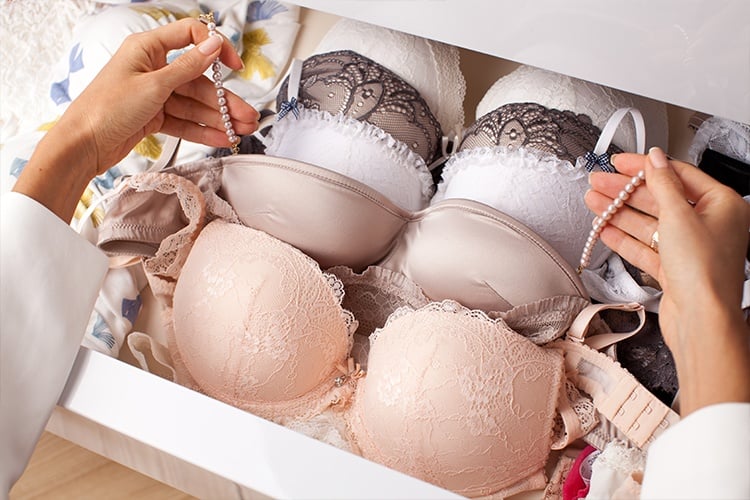
Brassiere, which is more popularly known as bra is a women’s inner wear that supports the breasts. Apart from its most important job to support breasts, these days it has also become a popular fashionable item and is longer a hidden wear, as it used to be.
The term ‘brassiere‘ was first used in 1893 in England and bagged a place in Oxford English Dictionary in 1911. By 1930, this terminology was more simplified to what we know as ‘bra’.

Source: pinterest.com
The history of brassiere is inevitably associated with the social history of women and not to mention the evolution in the fashion industry.
Since time immemorial, women have been trying to cover, maintain or modify the shape of their breasts by trying various kinds of inner wear and garments. With the onset of the 14th century, the wealthier women revolutionized this kin of inner wear with corset, which helped push the breast upwards.

Source: pinterest.com
Middle Ages
In the Middle Ages, women were rarely seen using any kind of garment to support their breasts and in some exceptional cases, they used a cloth binder. During the 1370 Holy Roman Empire, a widely citation states –
“No woman will support the bust by the disposition of a blouse or by tightened dress.”

Source: pinterest.com
In this era, the breasts were rather played down in dresses with high necklines, straight bodices and full skirts, which were designed mostly for functionality rather than giving importance to the form.
Renaissance
By Renaissance era, the décolletage had become quite popular. It is the upper part of a torso i.e. between neck and waist, including neck, back, shoulders and chest.
Catherine de’ Medici, wife of Henry II of France is widely blamed to make the use of corset popular in her country. She had prohibited the broad waists at court and was believed to make them wear steel-made corsets.

Source: pinterest.com
Although it is widely believed that the corset paved way to the bra, but with archeological findings of 4 linen bras in 2008, have again raised the question if the brassiere is the predecessor to the corset.
French Empire
The ‘Empire’ fashion mainly originated during the pregnancy of the then Empress Josephine, who had found it convenient to wear garments with a higher waistline, just beneath the breasts. This classical design soon became popular, as breasts got to be more visible than the waist. This period in Britain was known as the ‘Regency’.

Source: pinterest.com
Victorian Era
During this era, regardless of morality, the woman’s clothing was ridiculously designed to put emphasis on both the breasts and hips by tight lacing the waist part of the body. The Victorian ladies were seen hog-tied with multi-layered clothing, including a chemise (usually drawers), corset, corset cover, the under and over petticoat, hoop skirt and lastly the dress.

Source: pinterest.com
“The high-water mark of modesty would ebb after sunset some six inches!”
Women’s Inner wear Reformation
With the rising increase of women’s interest in sports, such as bicycling, soon cleavage exposure and bare arms became a fashion statement, thereby urging the use of brassiere.

Source: pinterest.com
19th Century Bra
The world’s oldest push-up bra is now exhibited in the Science Museum of London. This was specifically designed to enhance the cleavage.

Source: pinterest.com
However, it’s still unclear, who had invented the bra. Many dressmakers and manufacturers had come up with a variety of designs, claiming unique features and benefits.
According to Life Magazine, Herminie Cadolle of France in 1889 had first invented the modern bra. It came in a two-piece garment, which was known as corselet gorge. This design effectively cut the corset into two pieces; while the upper part was meant for breast, the lower part was meant for corset.

Source: pinterest.com
Groundbreaking Wonderbra campaign
Landmark ad for Wonderbra featuring Czech model Eva Herzigova.
In May 9, 1994, a significant shift in advertising lingerie occurred. Advertising executive Trevor Beattie, working for TBWA/London, developed an ad for Sara Lee’s “Hello Boys” Wonderbra campaign. It featured a close-up image of Czech model Eva Herzigová in a black Wonderbra with ample cleavage and the title, “Hello boys.” The bra was introduced in New York City and Eva’s figure wearing the Wonderbra was featured on the large 2,800 square foot billboard in New York’s Times Square.Critics complained that the photograph demeaned women. The ground-breaking, racy ad campaign was repeated across the United States, resulting in an explosion of sales that Sara Lee could not meet. The Wonderbra began selling at the rate of one every 15 seconds, generating first year sales of about US$120 million. Many competitors introduced their own cleavage-enhancing bras.

Source: pinterest.com
The brassiere has undergone enormous experiments and today it is considered more as a sensual statement. You can dig online to get bombarded with copious designs and sizes.
